
ALL YOU NEED TO KNOW ABOUT THE 2025 BAHRAIN GRAND PRIX
Table of Contents
Highly abrasive surface = major thermal tyre deg, Punishing braking zones, Stop-start layout puts a premium on traction, Setup compromise needed: roll stiffness vs. handling track warp, Tricky downhill & off-camber T9-10 sequence catches drivers out
Circuit History and Evolution
The Bahrain International Circuit (BIC), first appearing on the Formula 1 calendar in 2004, has become something of an old favorite, typically featuring early in the season schedule. Its debut marked F1's first World Championship event in the Middle East. Located south of the capital, Manama, in the Sakhir desert area, the circuit was constructed on land previously occupied by a camel farm. The build itself was rapid, completed in just 496 days from the initial breaking of ground.
Originally, the circuit's design seemed geared more towards a television audience, with limited grandstand capacity and vast expanses offering views primarily of desert hardpan. Over time, however, the Bahrain Grand Prix has successfully cultivated a following as a tourist destination. More grandstands have been erected to accommodate growing crowds, transforming it into one of the more convivial venues on the calendar.
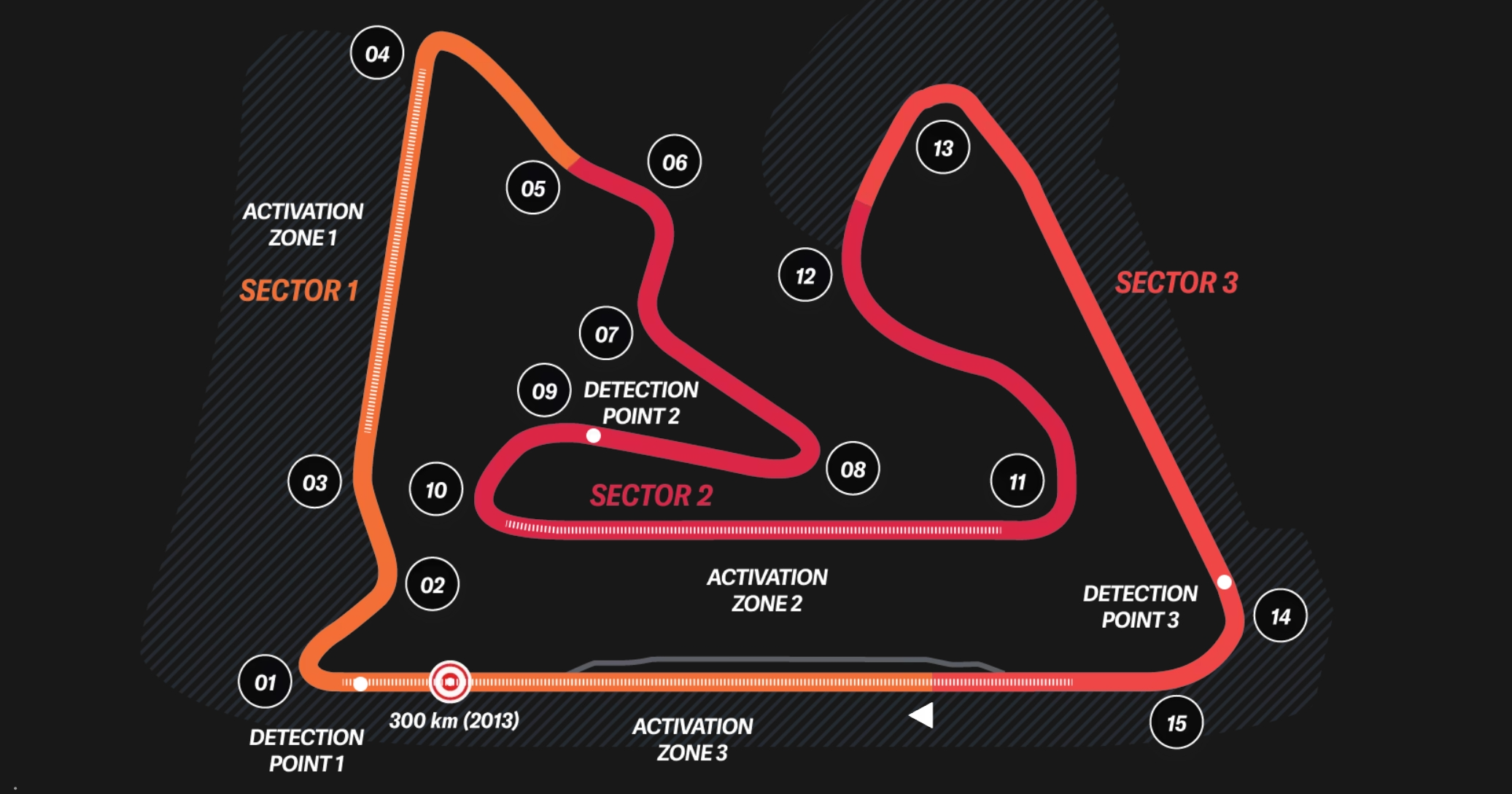
A significant shift occurred in 2014 when the race moved to a twilight start, finishing under floodlights. This change, combined with the addition of major post-race and qualifying concerts, has attracted a younger demographic and contributes to a distinct atmosphere during the warm, illuminated evenings. The circuit actively enhances this vibe with various entertainment, from circus acts to unconventional musical performers like hard rock bagpipe bands roaming the concourses.
The event has been staged 20 times since 2004, with the 2011 edition cancelled due to socio-political issues. In 2020, due to the pandemic-affected calendar, BIC hosted two consecutive races: the standard Bahrain Grand Prix followed a week later by the Sakhir Grand Prix, run on the shorter, faster 'Outer Circuit'.
Environment and Atmosphere
Situated in the middle of the desert, the circuit incorporates 1,120 palm trees within its boundaries. While its desert location might suggest sand being a constant problem, the surrounding areas are treated with a sticky adhesive substance to minimise the amount of sand blowing onto the track surface. Nevertheless, sand can still be a factor, particularly affecting grip levels early in the weekend and potentially finding its way into car cooling systems if winds are strong or shift direction. The Kingdom of Bahrain itself is an archipelago comprising 33 islands, known for its upscale resorts.
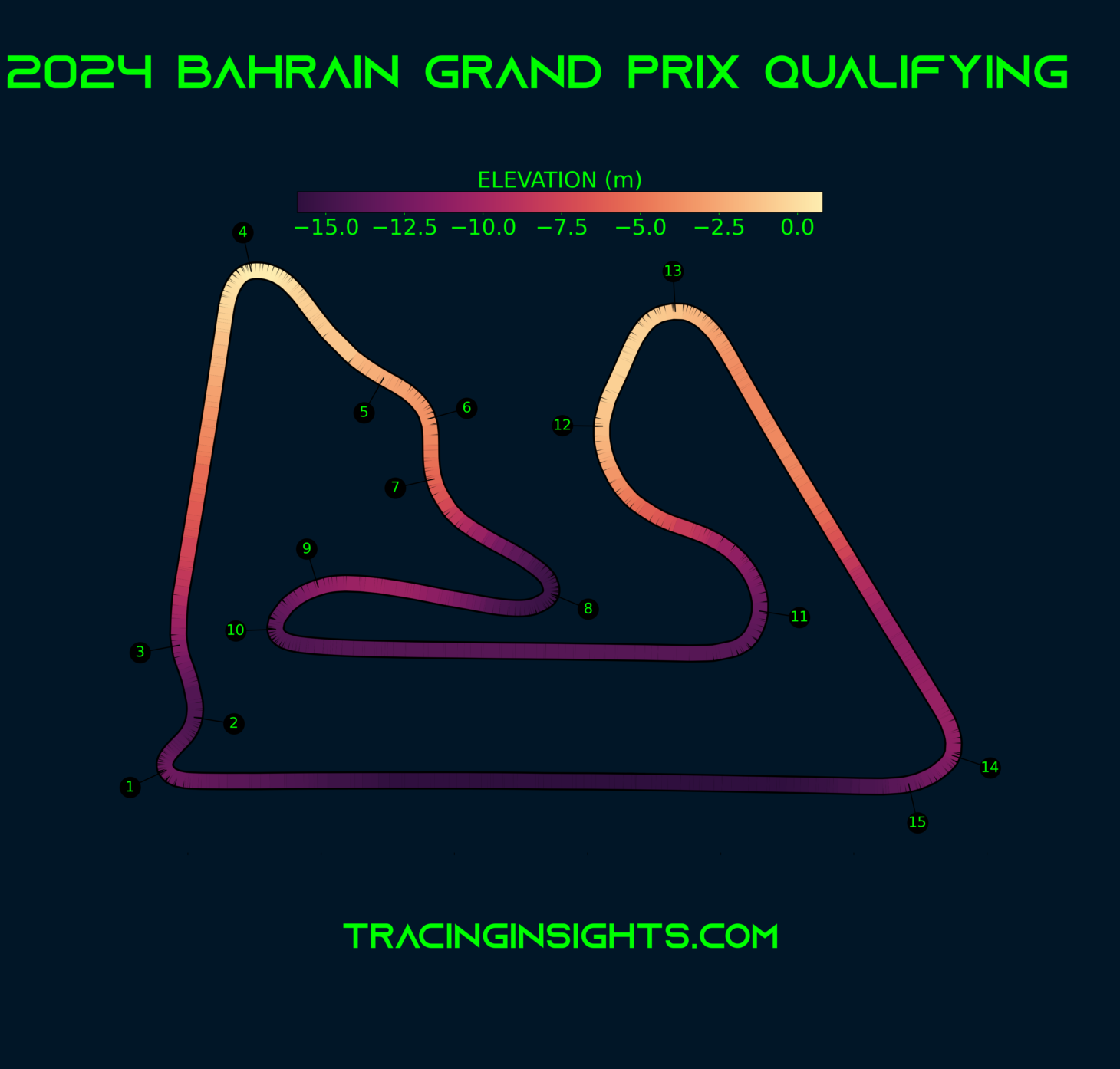
The grandstands are primarily clustered at the 'bottom' end of the circuit, stretching from the Victory Grandstands overlooking the final corner complex through to the University Grandstands at the Turn 1-2-3 complex. With a full support bill often including F2 and F3, the concourses behind the stands offer a place to relax, perhaps with a cool drink or a hubble bubble, providing a more gentle pace compared to many F1 venues.
Circuit Characteristics and Challenges
The 5.412 km (3.363 miles) Sakhir circuit is renowned for providing a comprehensive test of a car's capabilities, which is why it's frequently chosen for pre-season testing. It features a mix of elements: long straights demanding good power unit performance, low-, medium-, and high-speed corners testing aerodynamic balance and mechanical grip, kerbs to ride, and rapid changes of direction.
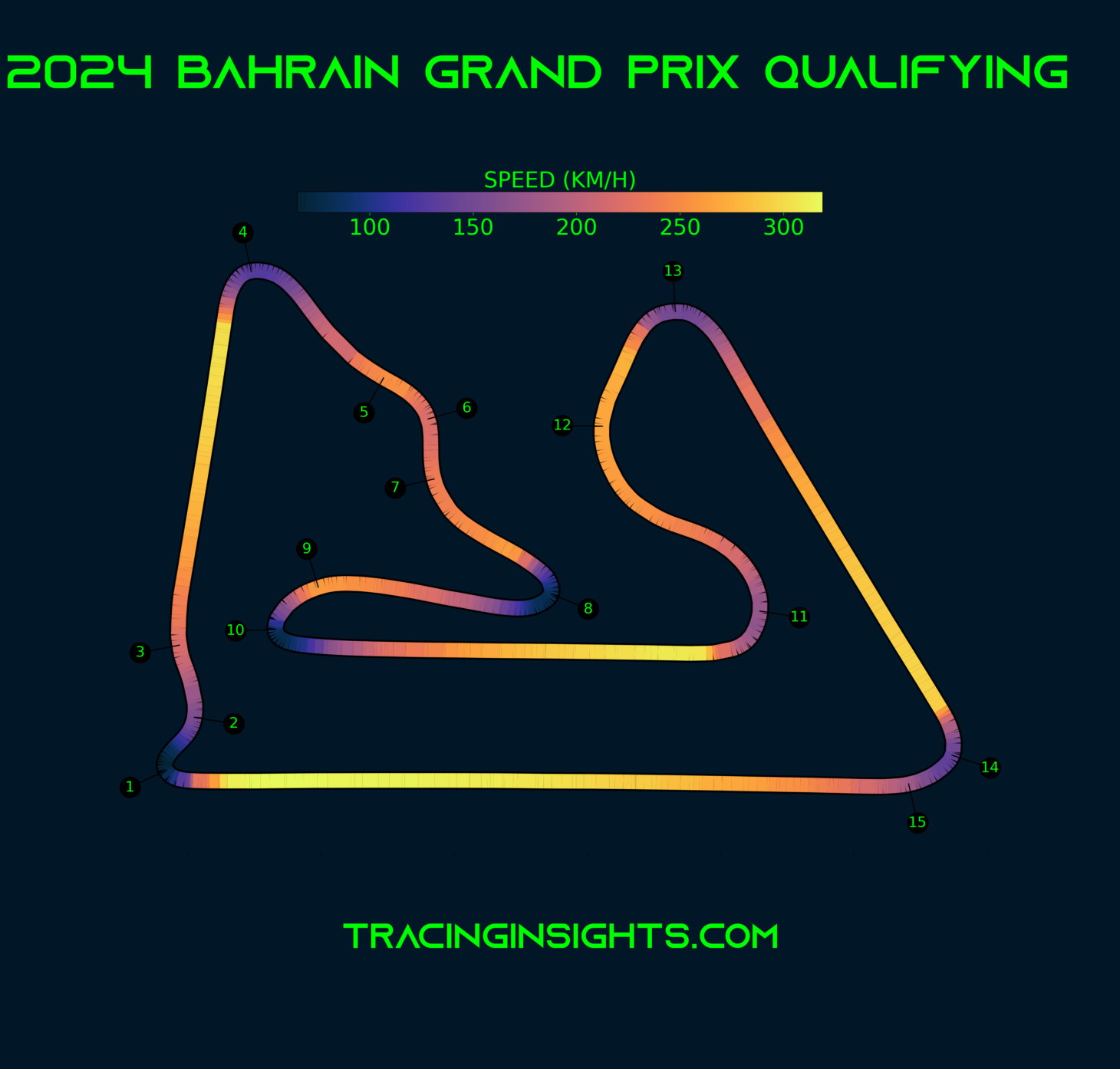
The layout consists of 15 corners – 9 right-handers and 6 left-handers. A defining feature is its abrasive track surface, constructed from a special aggregate shipped from a quarry in England. Despite its age, the asphalt remains highly abrasive, providing good tyre grip but also contributing significantly to tyre degradation.
The track's stop-start nature makes it difficult for drivers to find a consistent rhythm. It places a premium on traction out of the numerous low and medium-speed corners that precede the long straights. There's a setup compromise required between high roll stiffness for stability in the faster sections (like the sweeps up and down the hill) and lower roll stiffness to cope with the significant track warp found in some of the slower turns, ensuring good tyre contact for traction.
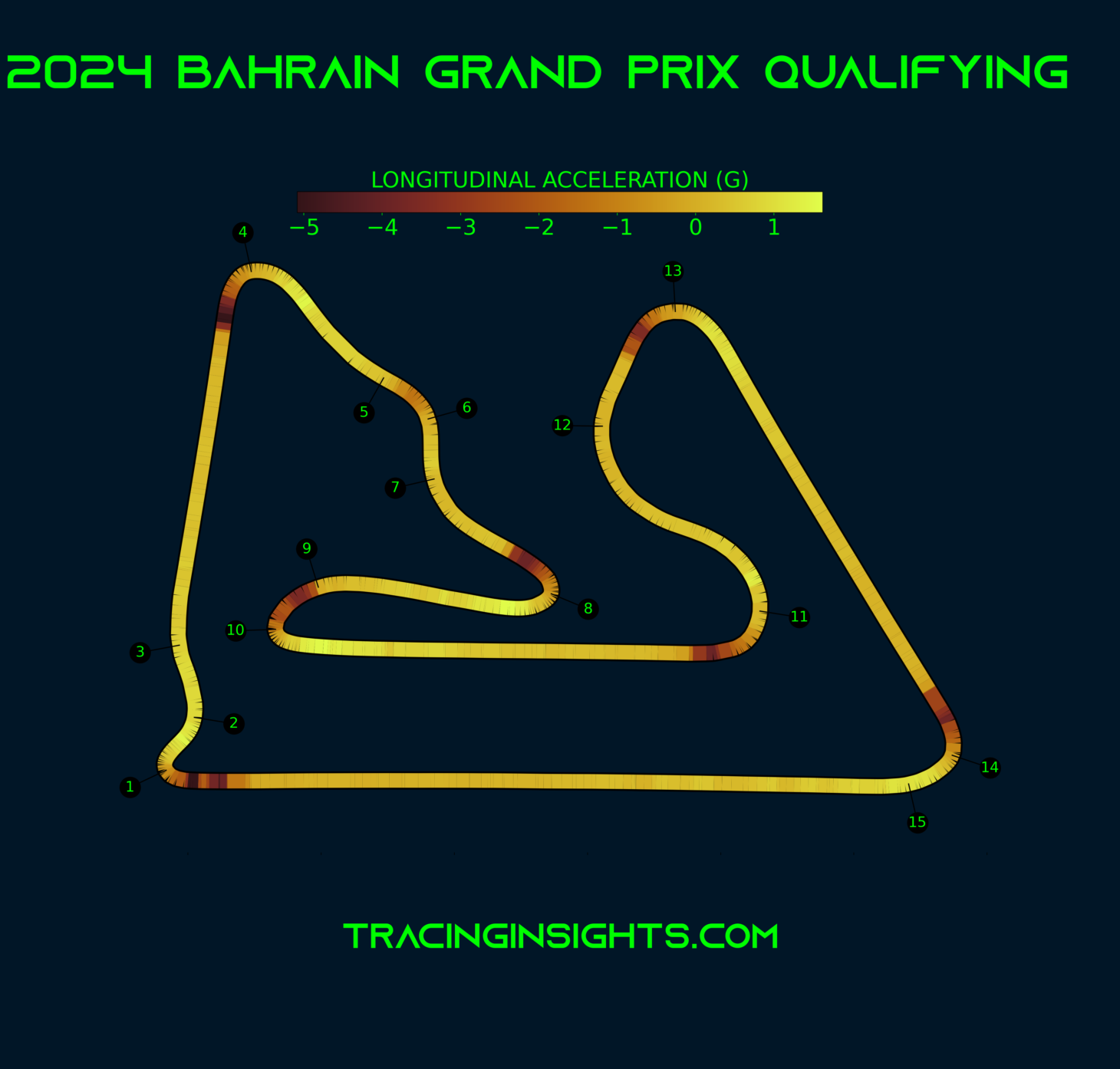
Technical Demands
Car setup here focuses heavily on optimising performance in low and medium-speed corners. Excellent mechanical grip is crucial for accelerating effectively out of the slower turns, while the high-speed sections are generally straightforward enough to be taken flat-out, placing less emphasis on peak downforce. Achieving good top speed on the straights is a primary objective.
The circuit is demanding on several car systems. The need for strong traction highlights the importance of rear tyre management. Cooling systems are also tested, not just by ambient heat but also by the potential for sand ingestion. The fluctuating temperatures between day and night sessions impact aerodynamic performance, cooling package efficiency, and overall car balance.
Pit Lane and Technical Features
The circuit boasts a substantial total run-off area covering 140,000 square metres. For the 2025 event, a few specific adjustments have been made following FIA reviews:
-
The gravel bed at the exit of the heavy-braking Turn 4 has been extended.
-
Certain U-drains located close to the racing line have been closed off and moved further away into the run-off areas.
-
Surface bumps identified on the start/finish straight and approaching Turn 9 have been repaired.
BIC holds five distinct FIA-certified track layouts. Formula 1 has utilised three of these for Grands Prix over its history:
-
The current 5.412 km Grand Prix circuit.
-
The 6.299 km 'Endurance Circuit' used only in 2010, featuring an extra loop between Turns 4 and 5, increasing the corner count to 24 and reducing the race distance to 49 laps.
-
The 3.543 km 'Outer Circuit' used for the 2020 Sakhir Grand Prix, essentially following the perimeter, turning left at Turn 4 and rejoining the main layout at Turn 13.
Key Corners
-
Turn 1: A very tight right-hander following the long pit straight. It's a prime overtaking spot, requiring drivers to brake heavily from over 300 km/h down to around 60 km/h. Maintaining position through the subsequent Turns 2 and 3 complex is also important.
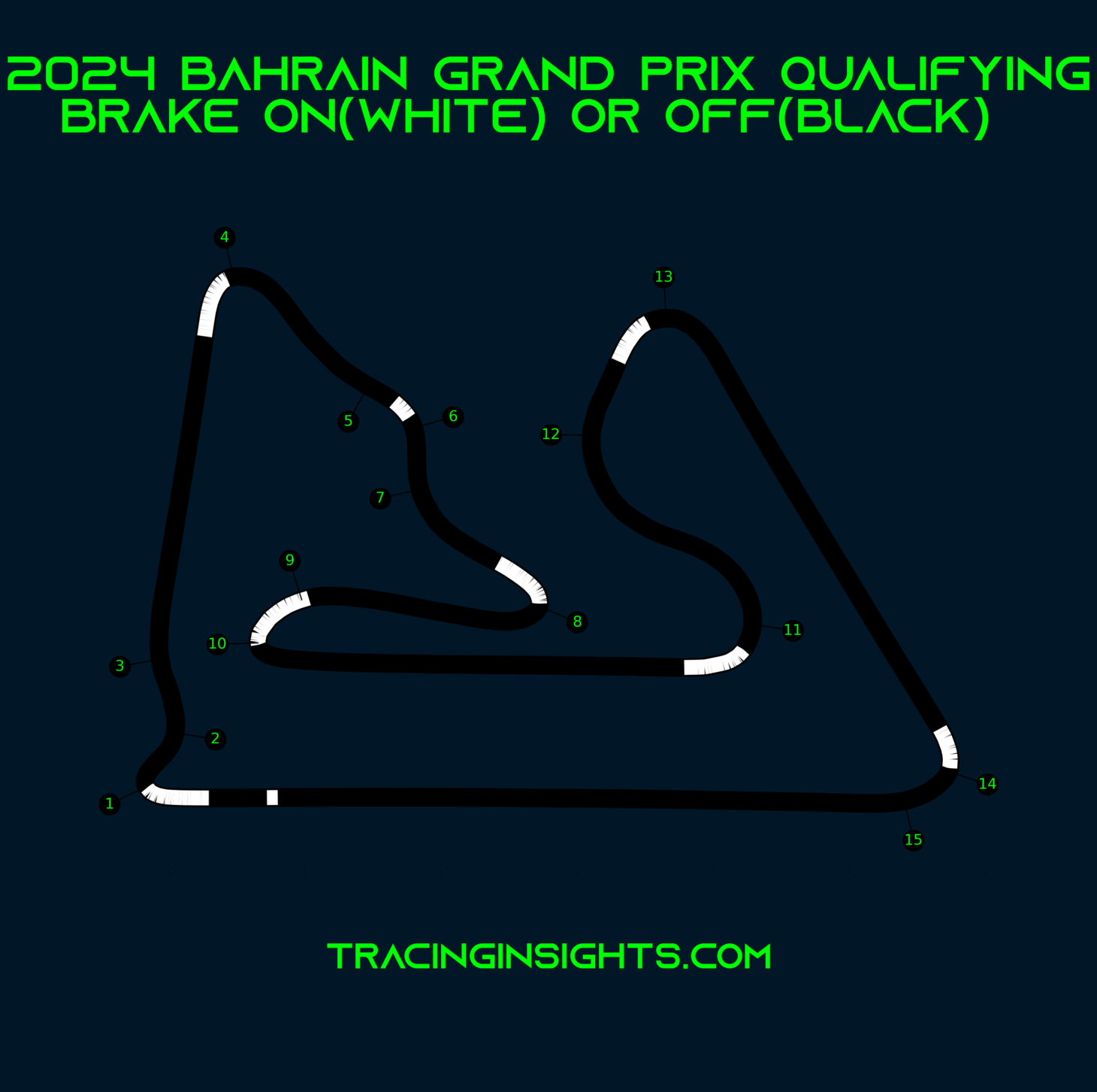
-
Turn 4: Another significant right-hander at the end of a straight with a DRS zone, presenting a further overtaking chance. Fighting cars here risk running wide at the exit, potentially incurring penalties. The gravel trap here has been extended for 2025.
-
Turns 9 & 10: A tricky downhill sequence. Turn 9 is a medium-speed left leading immediately into the very tight, off-camber Turn 10 left-hander (taken around 70 km/h after approaching Turn 9 at ~135 km/h). Precision and bravery are needed here; it frequently catches drivers out, allowing cars behind to close up or cars ahead to escape onto the following straight. Overcooking the entry into Turn 9 often leads to running wide at Turn 10, costing significant time.
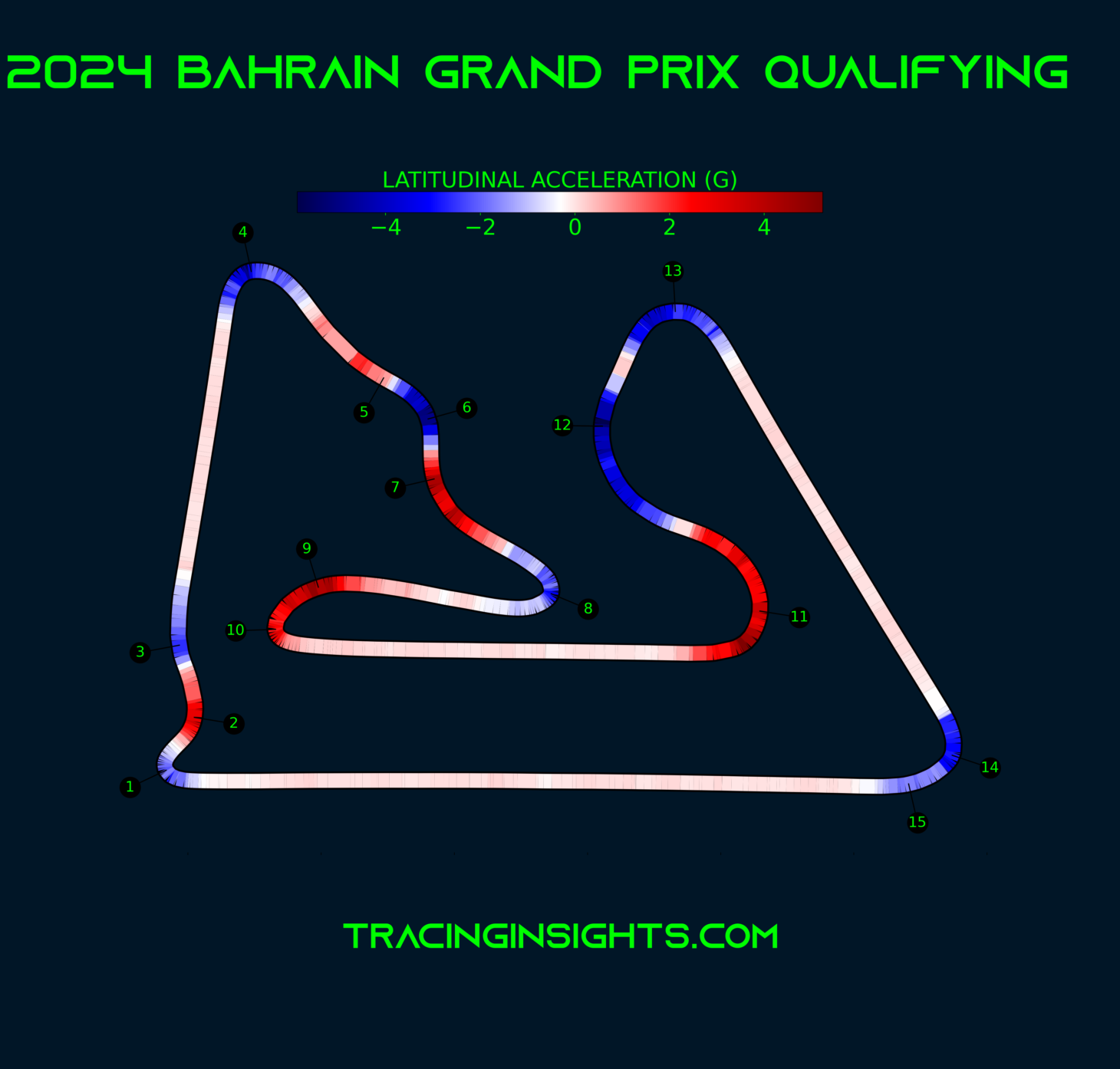
-
Turn 11: A medium-speed left at the end of another DRS straight, offering another potential overtaking point, especially if a driver gets a good run through the preceding sequence (Turns 5-10 are designed to allow cars to follow closely).
-
Turn 13: The exit of this right-hander is critical. A clean getaway is essential to maximise speed onto the main straight and defend against potential DRS-assisted attacks into Turn 1.
-
Sector 3: Characterised by undulations and sweeping corners, maintaining high speed through this final part of the lap is vital for the run down the pit straight.
Racing Considerations
The circuit was explicitly designed to promote close racing and overtaking. The combination of long straights and heavy braking zones facilitates wheel-to-wheel action.
The transition from daylight at the start (around 6 PM local time) to full darkness under floodlights presents unique challenges. Visibility changes, sometimes prompting drivers to use different visor tints. More significantly, the drop in ambient and track temperature affects car behaviour and tyre performance throughout the race.
Wind is often a factor. Its direction can change by as much as 180 degrees during the day, and gusts can be unpredictable. This affects aerodynamic balance, particularly on the exposed straights (pit straight, between T3-T4, T10-T11), while parts of the upper section of the track might be in wind shadow. Surprise snaps of oversteer induced by wind are not uncommon. While some sand is partially glued down, wind can still blow finer particles onto the track, affecting grip.
Safety Car deployment has been inconsistent. After only one appearance in 2007, there was a long gap until 2014, the first race at the track held at night. From 2017 through both 2020 races, every Grand Prix featured either a Virtual Safety Car or a full Safety Car period. However, the 2024 race ran without interruption, ending an eight-race streak. Whether 2025 sees a return to interventions remains to be seen.
Tyre Selection and Strategy
Tyre management is arguably the most critical factor in Bahrain. Pirelli has allocated the hardest compounds in their 2025 range: C1 (Hard), C2 (Medium), and C3 (Soft). This is the same allocation as seen in Suzuka, but the high track abrasiveness and expected temperatures demand a very different approach.
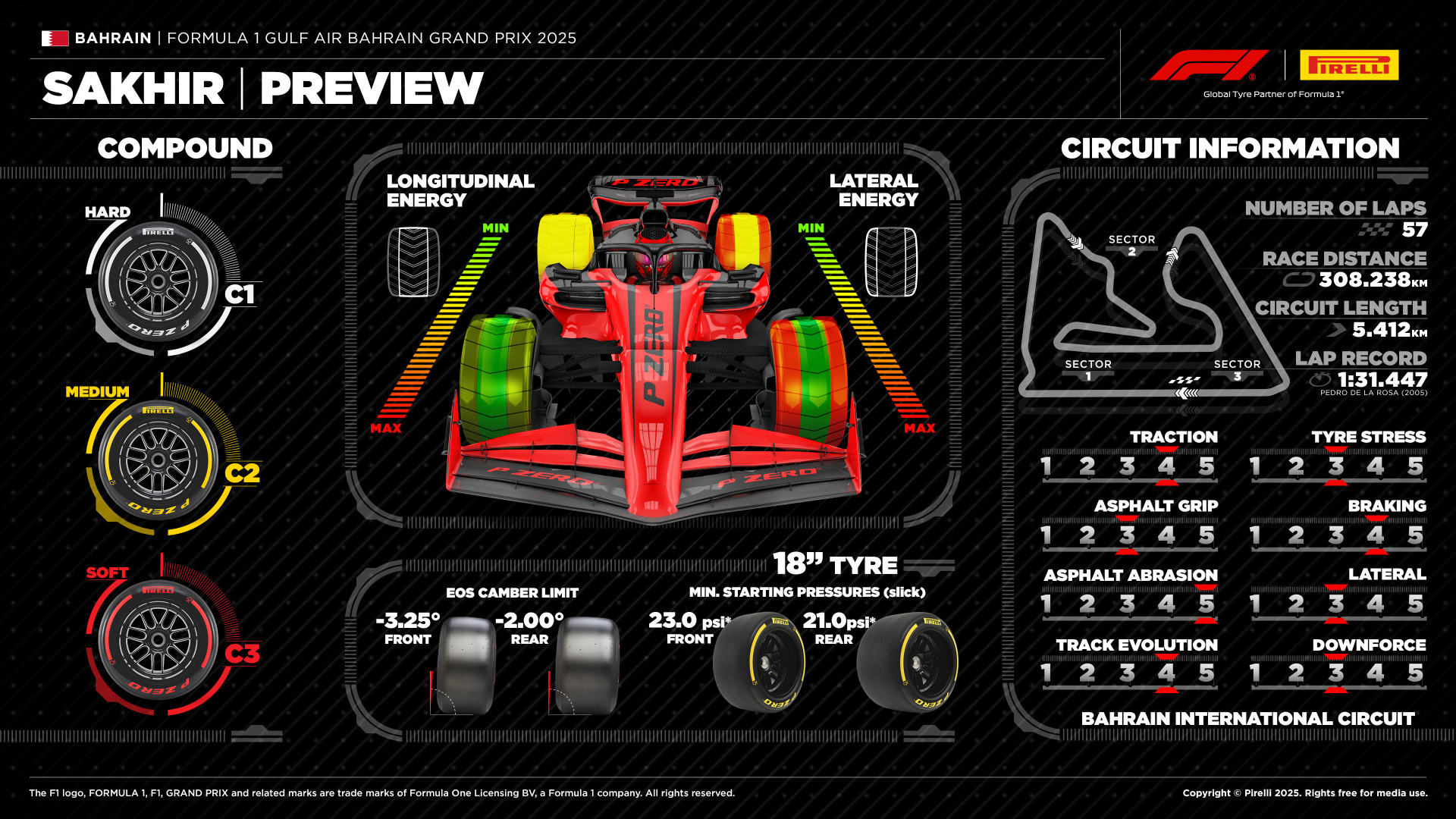
The main challenge stems from thermal degradation, especially impacting the rear tyres. This occurs when high energy input generates heat that alters the chemical bonds within the tread compound, leading to an irreversible loss of grip. While surface overheating (tyre sliding excessively, causing a temporary grip loss) can also occur, thermal degradation is the primary performance limiter. Tyre wear (physical abrasion of the tread) and graining are typically less of a concern here than managing the heat-induced degradation. A driver experiencing higher degradation than competitors may be forced into an earlier pit stop as the tyres reach the end of their effective performance life (distinct from their wear life, which is when the tread is physically gone).
Teams have a good starting point thanks to the three-day pre-season test held here in February. During that test (3,897 laps / 21,090 km total), the C3 Soft was used most extensively (67.17% of laps), followed by C2 Medium (20.88%) and C1 Hard (9.26%). However, that test ran in unusually cool and windy conditions. The much hotter temperatures expected for the race weekend will significantly alter tyre behaviour compared to the test data.
Minimum starting tyre pressures have been mandated at 23.0 psi front and 21.0 psi rear for this weekend. This reflects an increase of +1.0 psi front / +2.0 psi rear compared to the 2024 race, and +0.5 psi on both axles compared to the February 2025 test.
Modifications to the 2025 Pirelli compounds, with the C2 and C3 reportedly slightly softer and potentially offering a better performance delta between them compared to their predecessors, could influence strategy. This might bring the C2 Medium compound back into contention as a viable race tyre, potentially opening up more strategic options beyond the typical two-stop. A one-stop strategy might even become a realistic possibility, though this heavily depends on how well teams can manage degradation in the heat.
The three hours of free practice, particularly FP2 held under representative evening conditions, will be crucial for understanding tyre performance, lifespan, and degradation rates in race-relevant temperatures, informing qualifying and race strategy choices.
TRACK CHARACTERISTICS
TRACTION
4/5
TYRE STRESS
3/5
ASPHALT GRIP
3/5
BRAKING
4/5
ASPHALT ABRASION
5/5
LATERAL
3/5
TRACK EVOLUTION
3/5
DOWNFORCE
3/5
Last Year's Strategic Picture (2024)
The 2024 Bahrain Grand Prix reinforced the track's tendency towards multiple pit stops, seemingly making a two-stop strategy a given. Every driver made at least two stops, with Hulkenberg, Gasly, and Sargeant opting for three.
Interestingly, the C2 Medium tyre was largely ignored during the race. Despite performance being relatively close to the C1 Hard in testing, its higher expected degradation meant teams resolutely left it unused. The preferred compounds were the C3 Soft and C1 Hard.
The vast majority of the field started on the C3 Soft, then completed the race with two stints on the C1 Hard (Soft-Hard-Hard), having saved two sets of Hards specifically for the race. The main exception was Red Bull; Verstappen and Perez ran a Soft-Hard-Soft strategy, finishing 1-2. This was partly dictated by their tyre allocation, as they were the only team not to take two sets of Hard tyres into the race, but it also underlined their car's performance advantage at the time.
While the same C1/C2/C3 allocation applies this year, the tweaked 2025 Pirelli construction, which has appeared slightly more robust in early rounds, might alter the strategic calculations compared to 2024.
Braking Demands
Bahrain is notably hard on brakes. The circuit features several punishing braking zones, particularly into Turn 1 at the end of the main straight and Turn 4 after another DRS zone. Good braking stability and traction is rewarded. Brake temperatures and wear usually become more critical factors during the second half of the race, requiring careful management from the drivers, especially when running in traffic.
F1 BREMBO BRAKING DATA
| Turn | Initial Speed (km/h) | Final Speed (km/h) | Stopping Distance (m) | Braking Time (sec) | Maximum Deceleration (g) | Maximum Pedal Load (kg) | Braking Power (kW) |
|---|---|---|---|---|---|---|---|
| ≡ 01 | 313 | 66 | 124 | 2.89 | 4.2 | 133 | 2,112 |
| ≡ 04 | 305 | 123 | 107 | 2.10 | 4.2 | 132 | 2,095 |
| _ 06 | 255 | 212 | 36 | 0.55 | 2.9 | 65 | 939 |
| = 08 | 258 | 71 | 98 | 2.50 | 4.1 | 130 | 1,908 |
| = 10 | 255 | 68 | 104 | 2.70 | 3.6 | 103 | 1,456 |
| = 11 | 304 | 160 | 89 | 1.49 | 4.1 | 123 | 2,080 |
| = 13 | 275 | 146 | 85 | 1.56 | 3.9 | 117 | 1,791 |
| ≡ 14 | 296 | 118 | 103 | 2.02 | 4.2 | 130 | 2,070 |
Weather Outlook and Its Impact
The race weekend is expected to feature significantly different conditions compared to the chilly pre-season test in February (which saw mid-teen temperatures, power cuts, and even rain). Temperatures are likely to be around 20°C higher, with daytime highs potentially reaching 36°C.
The race starts at dusk (6 PM local) and finishes in darkness. This means ambient and track temperatures will continually drop from around 28°C at the start. This wide temperature fluctuation poses a challenge for engineers trying to find an optimal setup, as car balance, cooling efficiency, and tyre behaviour change throughout the event. FP1 and FP3, held in hotter daytime conditions, are not fully representative of the cooler qualifying and race conditions.
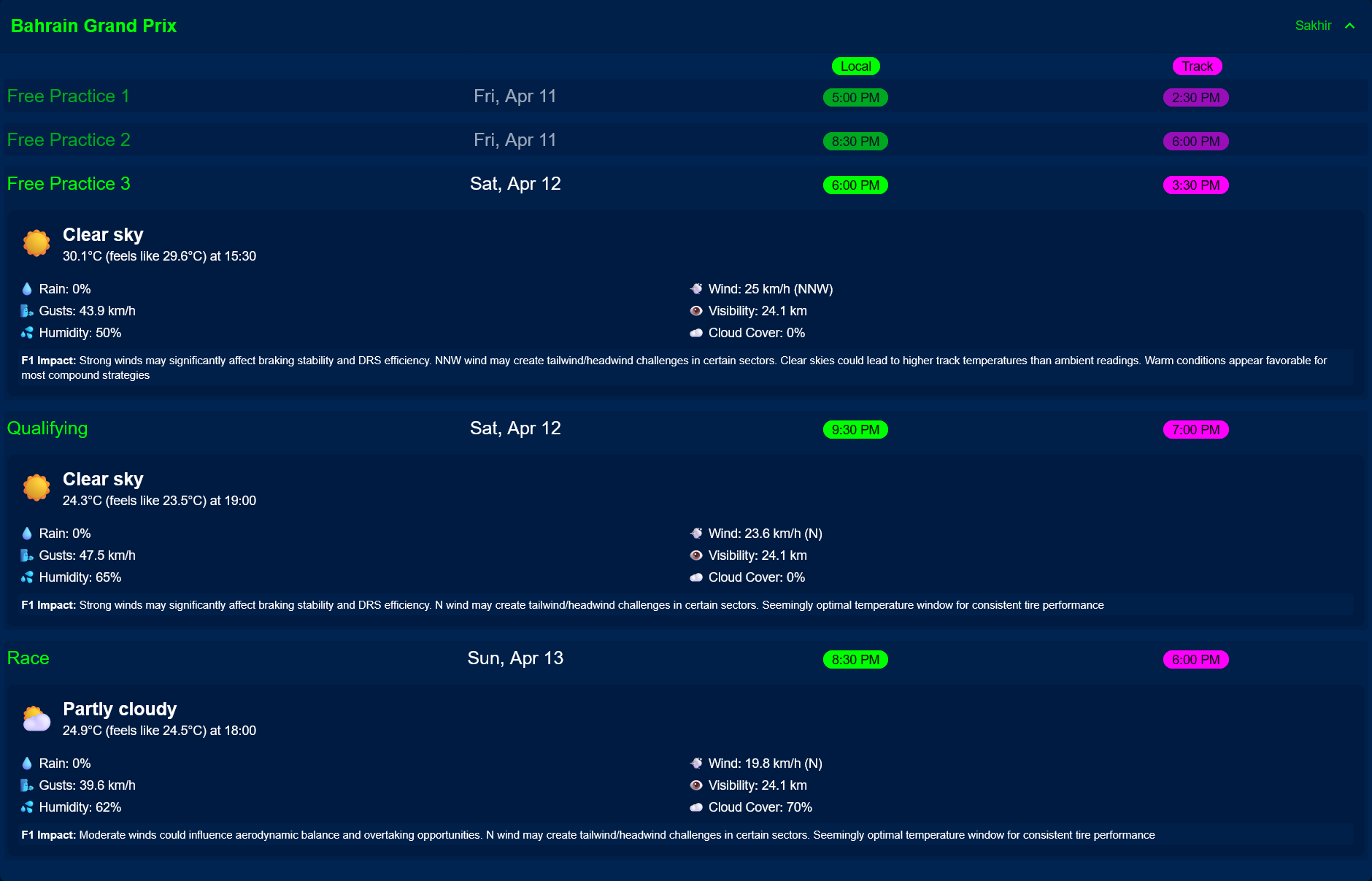
Wind is another significant weather variable. Its direction can change substantially during the day, and unpredictable gusts can upset car balance, leading to snaps of oversteer. While much of the trackside sand is treated, wind can still deposit some onto the surface, affecting grip, and potentially enter cooling intakes.
The heat might be challenging for drivers, although it's unlikely to reach levels where the FIA mandates in-car cooling devices. Expect teams to potentially test these systems during practice sessions anyway.
Overtaking Opportunities
The Bahrain International Circuit was designed with overtaking in mind and generally delivers good racing. There are several opportunities per lap:
-
Turn 1: The primary overtaking spot, at the end of the long pit straight and its DRS zone, involving heavy braking.
-
Turn 4: Following another straight with DRS, this right-hander offers the second-best chance, though carries a risk of running wide on exit. The addition of a third DRS zone on the run between Turns 3 and 4 in recent years allows battles unresolved at Turn 1 to continue up the hill, increasing action into Turn 4.
-
Turn 11: At the end of the back straight's DRS zone, this provides another opportunity, particularly if the attacking car gets a good run through the preceding technical section (Turns 5-10).
The circuit features four decent straights in total and three DRS zones, contributing to its reputation for facilitating wheel-to-wheel battles.
Historical Records and Statistics
-
Grands Prix Held: 20 (since 2004, excluding 2011)
-
Most Driver Wins: Lewis Hamilton (5)
-
Current Driver Wins: Fernando Alonso (3), Max Verstappen (2), Charles Leclerc (1)
-
Most Team Wins: Ferrari (7) - Schumacher (2004), Massa (2007, 2008), Alonso (2010)
-
Other Team Wins: Mercedes (6)
-
Most Pole Positions (Driver): Sebastian Vettel, Lewis Hamilton, Max Verstappen (3 each)
-
Most Pole Positions (Team): Mercedes (7)
-
Most Podiums (Driver): Lewis Hamilton (11)
-
Most Podiums (Team): Ferrari (17)
-
Lap Records:
-
Grand Prix Circuit (5.412 km): 1:31.447 (Pedro de la Rosa, McLaren-Mercedes, 2005) - Note: Michael Schumacher went faster in 2004 (1:30.252), but the record reset due to minor track reprofiling for 2005.
-
2025 Bahrain Grand Prix – Stat Sheet
Circuit Characteristics
| Characteristic | Value |
|---|---|
| Circuit Length | 5.412 km |
| Race Laps | 57 |
| Race Distance | 308.2 km |
| Number of Corners | 15 (6 L / 9 R) |
| Distance from Pole to First Braking Zone | 297 m |
| Pole Position Side | Left |
| Pit Lane Length Under Speed Limit Control | 421 m |
| Drive-Through Time at 80 km/h | 19s |
| Lap Time At Full Throttle | 61% |
| Lap Distance At Full Throttle | 71% |
| Gear Changes Per Lap | 55 |
| Braking Events (>2G) | 7 |
| Heavy Braking Events (<0.4s @ >4G) | 3 |
| Braking Energy | High |
| Maximum Lateral G-Force | 3.9 (T12) |
| Maximum Speed | 320 km/h |
| Fuel Consumption | High |
| DRS Zones | T3-4, T10-11, T15-1 |
| Key Overtaking Opportunities | T1, T4, T11 |
2024 Statistics
| Statistic | Value |
|---|---|
| Fastest Lap FP1 | 1:32:689 |
| Fastest Lap FP2 | 1:30.374 |
| Fastest Lap FP3 | 1:30:824 |
| Fastest Lap Q1 | 1:29:909 |
| Fastest Lap Q2 | 1:29:165 |
| Fastest Lap Q3 | 1:29:197 |
| Delta FP1 to Q3 | -3.692s |
| Delta Q1 to Q3 | -0.712s |
| Podium | VER/PER/SAI |
| Team Result | RUS P5 / HAM P7 |
| Fastest Race Lap | 1:33.706 (VER) |
| Winning Race Time | 1:31:44.742 |
| Winning Average Speed | 210 km/h |
| Qualifying Speed Trap | 327 km/h (VER) |
| Race Speed Trap | 332 km/h (HUL) |
| Winning Strategy | 2 Stops (L17 / L37) |
| Total Pit Stops | 43 |
| Total Normal Overtakes | 5 |
| Total DRS Overtakes | 22 |
| Race Lap Record | 1:31:447 (DLR, 2005) |
| Absolute Lap Record | 1:27.264 (HAM, Q3, 2020) |
| Not Classified (Accident/DSQ) | 0 |
| Not Classified (Mechanical) | 0 |
Race Characteristics (2020–2024)
| Characteristic | Value |
|---|---|
| Races Featuring Safety Car | 3/5 |
| Total Safety Car Deployments | 4 |
| Safety Car Probability | 60% |
| Safety Car Ratio | 0.8 |
| Wet Sessions | 0/25 |
| Wet Session Probability | 0% |
| Average Track Temperature | 25°C |
| Maximum Track Temperature | 28°C |
| Average Ambient Temperature | 22°C |
| Maximum Ambient Temperature | 26°C |
| Ambient Pressure | 1011.6 hPa |
Tyre Allocation
| Compound | Sets Per Driver |
|---|---|
| Soft | 8 |
| Medium | 3 |
| Hard | 2 |
Follow me on Whatsapp, Telegram, Facebook, YouTube, LinkedIn, Pixelfed, Tumblr, Bsky, Twitter, Mastodon, Instagram, Sub-Reddit, Threads for more analysis!